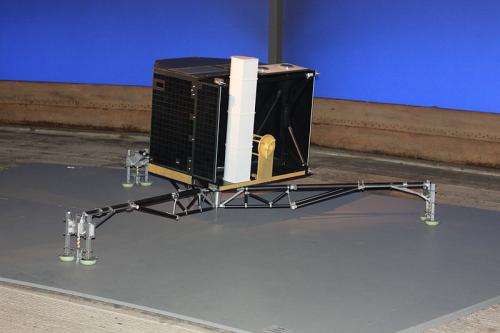A timeline of comet probe's 11-year journey

The European Space Agency said Sunday that its comet lander Philae has woken up from hibernation and managed to send data back to Earth for the first time in seven months. The probe went quiet on Nov. 15, three days after it was separated from its mother ship Rosetta and touched down on the city surface of comet 67P/Churyumov-Gerasimenko.
Here's a look at key moments during the mission:
___
March 2, 2004: Europe's unmanned probe Rosetta takes off from Kourou, French Guiana, after a series of delays, including an abandoned January 2003 launch window because of a rocket problem.
Feb. 25, 2007: Rosetta carries out a close flyby of Mars. European Space Agency's mission control breaks out in applause after the end of 15 tense minutes of radio silence as the craft passes behind the Red Planet.
Sept. 5, 2008: Probe successfully passes close to an asteroid 250 million miles from Earth. The spacecraft loses its radio signal for 90 minutes as planned during the flyby of the Steins asteroid, also known as Asteroid 2867.
July 10, 2010: Between Mars and Jupiter, Rosetta transmits its first pictures from the largest asteroid ever visited by a satellite after it flies by Lutetia as close as 1,900 miles (3,200 kilometers). It is the closest look to date at the Lutetia asteroid.
Jan. 20, 2014: Waking after almost three years of hibernation, Rosetta sends its first signal back to Earth. Systems had been powered down in 2011 to conserve energy, leaving scientists in the dark for 31 months.
Aug. 6, 2014: Rosetta swings alongside comet 67P/Churyumov-Gerasimenko somewhere between the orbits of Mars and Jupiter.
Nov. 12, 2014: The probe releases the Philae lander and it drops to the comet's surface. Seven hours later, Philae touches down on the comet.
Nov. 15, 2014: Philae goes into hibernation after performing experiments and sending data back to Earth for 60 hours.
Feb. 14, 2015: Rosetta swoops to a distance of just 6 kilometers (less than 4 miles) above the surface of the comet to take close-up pictures of the surface.
June 11, 2015: Scientists say they may have caught a glimpse of Philae, whose exact location remains unknown. After analyzing images and other data collected over the past months they identified several possible sites including one bright spot described as "a good candidate for the lander."
June 13, 2015: Philae communicates with Earth for the first time in seven months in a sign that it has come out of hibernation.
© 2015 The Associated Press. All rights reserved.





















